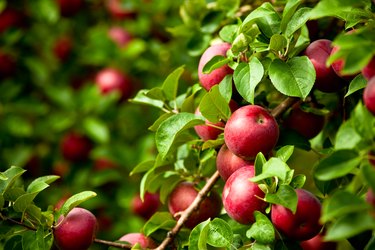
In plants that produce fruit, the fruit serves as a receptacle for seeds. In order to propagate, plants need those seeds to grow where they will not compete with the mother plant for water and nutrients. Because plants cannot move, most need external forces, like wind, water and even animals, to transport their fruit. Some plant species, however, have mechanisms that allow them to disperse their seeds without any help.
Dehiscent vs. Indehiscent Fruit
Video of the Day
When it comes to seed dispersal, there are two types of fruit: dehiscent and indehiscent. In the case of dehiscent fruit, the seeds are expelled from the fruit, which sometimes stays on the plant. The term "indehiscent" applies when the seed and the fruit become detached from the plant as one.
Video of the Day
Passive Seed Dispersal
Many plants depend on outside forces, such as wind, to disperse their seeds. This is known as allochory seed dispersal. Fruit that is dispersed by the wind is dry and has winglike tissue structures that allow it to be carried away through the air. These types of fruit are known as samaras. The silver maple is an example of a tree that produces samara fruit that is spread though the wind.
In other cases, seeds are contained inside lightweight, buoyant fruit that can float away from the parent plant on water. Coconuts, which can be transported by ocean currents, are the best known example of a fruit seed dispersed by water. Willow and silver birches also produce fruit that is dispersed in this manner.
Seeds Dispersed by Animals
Some fruits rely on animals to disperse them. This is called zoochory, and it can happen in a variety of ways. In the case of the cocklebur plant, for example, the fruits have spines that help them cling to the coat of furry animals. Inside each fruit are two seeds that can sprout elsewhere if the conditions are right. Squirrels, on the other hand, simply bury acorns and other nuts for safekeeping, and some of these will grow into trees.
Many plants have fruit that animals find appetizing. When an animal consumes the fruit, the seeds pass through its digestive system and are excreted far from the parent plant. They then germinate. This process has a name: endozoochoric seed dispersal. Elephants in the African savanna, for example, consume wild fruit as part of their diet and can transport the seeds as far as 40 miles. In Australia, a flightless bird known as a cassowary is almost entirely responsible for dispersing the seeds of the cassowary plum in this way, hence the fruit's name.
Autochory Seed Dispersal
Some plants do have the capacity to disperse their own seeds, which is called autochory seed dispersal. The aptly named squirting cucumber, for example, produces fruit that explodes when ripe. The force of the explosion sends seeds flying. In the case of the squirting cucumber, water pressure triggers the explosion.
Other plants simply count on gravity to disperse their fruit. This is known as barochory seed dispersal. In these instances, the seeds are encased in fruit, such as nuts, that fall and can bounce or roll away from the parent plant.
- Lumen: Fruit and Seed Dispersal
- The University of Texas at Austin Biodiversity Center: The Power of Poop
- Science Magazine: ‘This Is Amazing!’ African Elephants May Transport Seeds Farther Than Any Other Land Animal
- Kew Gardens: How Plants Hitchhike on Animal Poo
- Britannica: Falling Far from the Tree: 7 Brilliant Ways Seeds and Fruits Are Dispersed